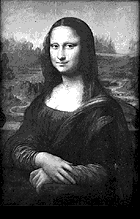| back to: Chapter 3 | Issues and Ideas in Renaissance Art |
|
Madonna Enthroned Madonna Enthroned | ITALIAN PRE-RENAISSANCE ART
-Renaissance means "rebirth" of Classical ideas and styles
-egg tempera paintings were done on carefully prepared wood panels Cimabue-heavily influenced by Byzantine works
Madonna Enthroned, 1280-90, tempera on wood, 12' 7"x 7' 4" Giotto- called "father of Renaissance painting"
Madonna Enthroned, c. 1310, tempera on wood, 10' 8"x 6' 8" Arena Chapel in Padua, Italy had an entire interior of frescoes by Giotto -Lamentation, Pieta, Kiss of Judas, and the Flight into Egypt, Last Judgment, Crucifixion, and Justice are some stories depicted Ambrogio Lorenzetti
Allegories of Good Government: The Effects of Good Government in the City and Country
|
Holy Trinity Dead Christ David |
EARLY RENAISSANCE
-Most of what we base our Western society on was set in motion during it.
FLORENCE
Florence Baptistery Door Competition of 1401
The Sacrifice of Isaac, 1401-2, gilt bronze relief, 21"x 17" ARCHITECTURE Brunelleschi-credited with the invention of linear perspective.
The Dome of Florence Cathedral, 1417-36, Brunelleschi PAINTING -linear perspective was a system set up to help create the illusion of three-dimensional space in a two-dimensional format. It originated in the Near East where some nomads noticed that a small pinhole carried an upside-down picture of the outside, in a dark tent, in the middle of the day. This later was used by Renaissance artists in the form of a camera obscura (Latin for black box). Artists would build small dark booths and move them to wherever they wanted to paint, then poke a pinhole in the wall, and copy the scene that was projected upside-down on the wall behind them. The system is based on the idea of a constant horizon line (eye level) where a vanishing point is located. One can anticipate the convergence of parallel lines at the vanishing point. Masaccio
Holy Trinity -Masaccio, 1425, fresco, 21' 9"x 9' 4" Sandro Botticelli
Birth of Venus,-egg tempera on wood, 1482, 5' 8"x 9' 1" Andrea Mantegna-
Dead Christ, c. 1500, tempera on canvas, 27' x 32" |
 Mona Lisa School of Athens David | HIGH RENAISSANCE IN ITALY chiaroscuro-a formula for creating light/shadow to create the illusion of 3-D space. It was practiced by all the Italian Renaissance painters.
Donatello, 1386-1466
Leonardo da Vinci, 1452-1519
Raphael, 1483-1520
Michelangelo, 1475-1564
Titian
|
|
Merode Altarpiece Arnolfini Wedding Portrait Peasant Dance Four Horsemen of the Apocalypse | NORTHERN EUROPEAN RENAISSANCE
The Renaissance in the North of Europe varied from Italy in several ways:
Glazing is a style of oil painting that employs the application of thin layers of paint that are transparent. By building up the layers, one can achieve a great deal of depth in a painting and the work also conducts light. Light will pass through the layers, then be reflected back out making the painting very luminous. Most Northern artists studied in Italy Fifteenth Century Flanders Merode Altarpiece, Robert Campin (Master of Flemalle), 1425-30, tempera and oil on wood, central panel is 25"x 25"
Jan van Eyck and (Hubert van Eyck), 1390-1441
Sixteenth Century Painting in Northern Europe Hieronymous Bosch, 1450-1516
Pieter Brueghel the Elder, 1525-69
Albrecht Durer, (1471-1528)
printmaking-is a process where an artist creates images that are transferred to another surface after they are prepared. Two kinds of printmaking are mentioned in the text: woodcut, which is the carving of a wood block and then inking the raised surface left behind, and engraving, which is the carving of metal plates in which the carved out areas become the part which holds ink and when printed.
Matthias Grunewald, (d. 1528)
Hans Holbein the Younger, (1497-1543)
|
| Next study guide: Chapter 5 |

Custom Search
|